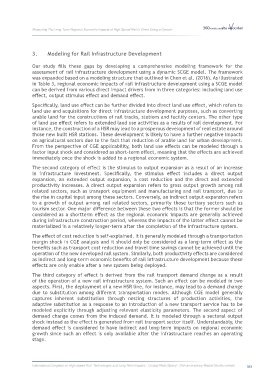Page 395 - 360.revista de Alta Velocidad - Nº 5
P. 395
Measuring The Long-Term Regional Economic Impacts of High-Speed Rail in China Using a Dynami
3. Modeling for Rail Infrastructure Development
Our study fills these gaps by developing a comprehensive modeling framework for the
assessment of rail infrastructure development using a dynamic SCGE model. The framework
was expanded based on a modeling structure that outlined in Chen et al. (2016). As illustrated
in Table 3, regional economic impacts of rail infrastructure development using a SCGE model
can be derived from various direct impact drivers from in three categories: including land use
effect, output stimulus effect and demand effect.
Specifically, land use effect can be further divided into direct land use effect, which refers to
land use and acquisitions for direct infrastructure development purposes, such as converting
arable land for the constructions of rail tracks, stations and facility centers. The other type
of land use effect refers to extended land use activities as a results of rail development. For
instance, the construction of a HSR may lead to a prosperous development of real estate around
those new built HSR stations. These development is likely to have a further negative impacts
on agricultural sectors due to the fact that reduction of arable land for urban development.
From the perspective of CGE applicability, both land use effects can be modeled through a
factor input shock and considered as short-term effect, meaning that the effects are achieved
immediately once the shock is added to a regional economic system.
The second category of effect is the stimulus to output expansion as a result of an increase
in infrastructure investment. Specifically, the stimulus effect includes a direct output
expansion, an extended output expansion, a cost reduction and the direct and extended
productivity increases. A direct output expansion refers to gross output growth among rail
related sectors, such as transport equipment and manufacturing and rail transport, due to
the rise in capital input among these sectors. Conversely, an indirect output expansion refers
to a growth of output among rail related sectors, primarily those tertiary sectors such as
tourism sector. One major difference between these two effects is that the former should be
considered as a shortterm effect as the regional economic impacts are generally achieved
during infrastructure construction period, whereas the impacts of the latter effect cannot be
materialized in a relatively longer-term after the completion of the infrastructure system.
The effect of cost reduction is self-explained. It is generally modeled through a transportation
margin shock in CGE analysis and it should only be considered as a long-term effect as the
benefits such as transport cost reduction and travel time savings cannot be achieved until the
operation of the new developed rail system. Similarly, both productivity effects are considered
as indirect and long-term economic benefits of rail infrastructure development because these
effects are only enable after a new system being deployed.
The third category of effect is derived from the rail transport demand change as a result
of the operation of a new rail infrastructure system. Such an effect can be modeled in two
aspects. First, the deployment of a new HSR line, for instance, may lead to a demand change
due to substitution among different transportation modes. Although CGE model generally
captures inherent substitution through nesting structures of production activities, the
adaptive substitution as a response to an introduction of a new transport service has to be
modeled explicitly through adjusting relevant elasticity parameters. The second aspect of
demand change comes from the induced demand. It is modeled through a sectoral output
shock instead as the effect is generated from rail transport sector itself. Understandably, the
demand effect is considered to have indirect and long-term impacts on regional economic
growth since such an effect is only available after the infrastructure reaches an operating
stage.
International Congress on High-speed Rail: Technologies and Long Term Impacts - Ciudad Real (Spain) - 25th anniversary Madrid-Sevilla corridor 393

